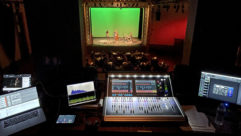
Virtual Dinner
Apr 1, 2008 12:00 PM,
By Michael Goldman

I recall distinctly when it first dawned on me that modern videoconferencing was not just a niche business tool, but a technology with potential to be a paradigm-shifting communications system capable of impacting how future societies (not just businesses) might communicate.
It was 2005, and I was researching an article for Sound & Video Contractor‘s sister publication millimeter about how movie studios were using conferencing tools to organically collaborate in realtime on movie production. While working with its subsidiary PDI, in Northern California, to make the all-CG animated film Madagascar, DreamWorks, in Southern California, had brought its Virtual Studio Collaboration (VSC) system fully online. The system permitted artists at DreamWorks to essentially sit face-to-face at the same conference table (or, at least, an exact replica) with their colleagues from PDI, even though they were hundreds of miles away, during production meetings.
The system, still in use today, was largely built on HP’s Halo Virtual Collaboration Studio broadcast technology in combination with some proprietary tools developed inhouse at DreamWorks as well as a wide range of AV products — including recessed cameras, zoomed document cameras, and plasma displays. The primary goal was to create a virtual conference room between the two sister studios. Since that time, many options for others in the business world to achieve similar goals — ranging from web-conferencing services to expensive virtual conference rooms such as VSC — have been developed, and those technologies are at use at major corporations across the globe.
Today, we see HD imagery being added to the mix (see p. 30 for Jay Ankeney’s look at HD videoconferencing) and a host of different, scalable platforms being offered. What I didn’t think about back then is how videoconferencing also has the potential to be a green alternative for businesses, in addition to a travel and shipping cost saver generally. That is the subject of a column we’re working on right now, to appear in these pages in the near future.
With the rise of web-camera systems, I’m also realizing the basic concept behind such technology is bleeding into the consumer world in less sophisticated (and less expensive) ways. All of that leads me to wonder: How long will it be before videoconferencing setups like DreamWorks’ VSC system become available in the smart homes of the near future? Imagine sitting down for a virtual dinner once a week with your relatives across the country.









